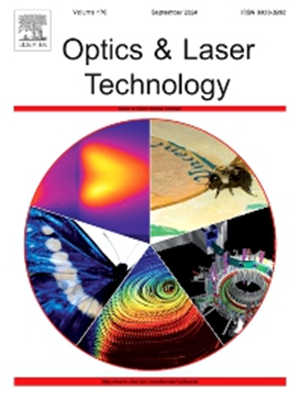基于语义编码的语义鬼影成像
IF 4.6
2区 物理与天体物理
Q1 OPTICS
引用次数: 0
摘要
为了解决幽灵成像(GI)过程中在低采样率下重建高质量图像的难题,我们提出了一种基于语义编码的语义 GI 方法。通过训练,卷积核的连续权重被用作斑点模式。然后采用处理模块和循环神经网络(RNN)对图像进行解码和重建。为了更好地提取目标物体的语义信息,对斑点模式及其相应的桶值都进行了优化。针对不同数据集的目标对象采用不同的门控递归单元(GRU)层,通过数值模拟和对简单目标对象(手写数字 "0 "至 "9")和复杂目标对象("NUPT")的实验,验证了所提出的 GI 方法的可行性。结果表明,即使在 1.28% 的较低采样率下,目标对象(手写数字)也能以较高的质量重建。此外,所提出的方法还适用于实际应用中更为复杂的对象(如 "NUPT")。与使用传统鬼影成像(TGI)、深度卷积自动编码器网络(DCAN)和基于 RNN 的 GI(GI-RNN)的结果相比,所提出的 GI 方法在重建图像质量和训练时间方面都有更好的表现,即所提出的方法既能获得良好的重建图像质量,又能获得较少的训练时间。通过在 GI 中引入语义通信的概念,所提出的方法为基于模型的 GI 提供了一种新的思路。本文章由计算机程序翻译,如有差异,请以英文原文为准。
Semantic ghost imaging based on semantic coding
To address the challenge of reconstructing high-quality images under low sampling during the Ghost Imaging (GI) procedure, we propose a semantic GI method based on semantic encoding. Through training, the obtained continuous weights of the convolution kernels are served as the speckle patterns. A processing module and a Recurrent Neural Network (RNN) are then employed to decode and reconstruct the images. Both the speckle patterns and their corresponding bucket values are optimized, so that the semantic information of the target object can be better extracted. With different gated recurrent units (GRU) layers for the target objects in different datasets, the feasibility of the proposed GI method is validated by the numerical simulations and experiments on the simple target objects (the handwriting digits “0” to “9”) and more complex target objects (“NUPT”). The results show that the target objects (the handwriting digits) can be reconstructed with higher quality even at a lower sampling rate of 1.28%. Additionally, the proposed method has applicability for more complex objects (such as “NUPT”) in real applications. In comparison with those results by using traditional ghost imaging (TGI), deep convolution auto-encoder network (DCAN), and RNN-based GI (GI-RNN), the proposed GI method shows a better performance in terms of the quality of reconstructed images and the training time, that is, the proposed method can have both good reconstructed image quality and less training time. By introducing the concept of semantic communication into GI, the proposed method provides a new idea for the model-based GI.
求助全文
通过发布文献求助,成功后即可免费获取论文全文。
去求助
来源期刊
CiteScore
8.50
自引率
10.00%
发文量
1060
审稿时长
3.4 months
期刊介绍:
Optics & Laser Technology aims to provide a vehicle for the publication of a broad range of high quality research and review papers in those fields of scientific and engineering research appertaining to the development and application of the technology of optics and lasers. Papers describing original work in these areas are submitted to rigorous refereeing prior to acceptance for publication.
The scope of Optics & Laser Technology encompasses, but is not restricted to, the following areas:
•development in all types of lasers
•developments in optoelectronic devices and photonics
•developments in new photonics and optical concepts
•developments in conventional optics, optical instruments and components
•techniques of optical metrology, including interferometry and optical fibre sensors
•LIDAR and other non-contact optical measurement techniques, including optical methods in heat and fluid flow
•applications of lasers to materials processing, optical NDT display (including holography) and optical communication
•research and development in the field of laser safety including studies of hazards resulting from the applications of lasers (laser safety, hazards of laser fume)
•developments in optical computing and optical information processing
•developments in new optical materials
•developments in new optical characterization methods and techniques
•developments in quantum optics
•developments in light assisted micro and nanofabrication methods and techniques
•developments in nanophotonics and biophotonics
•developments in imaging processing and systems

 求助内容:
求助内容: 应助结果提醒方式:
应助结果提醒方式:


